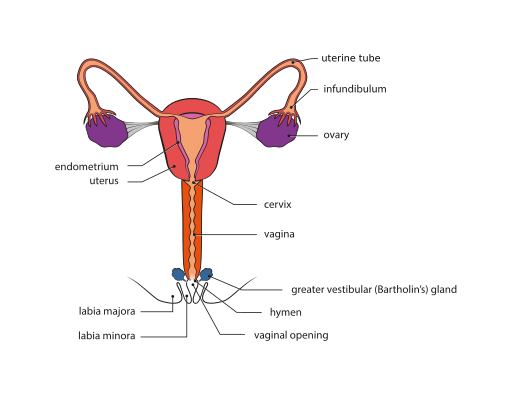PDF chapter test TRY NOW
In this section, we are going to learn about the female reproductive system. The female reproductive system is comprised of:
1. A pair of ovaries. The female gametes or eggs are produced in the ovaries.
2. A pair of oviducts or fallopian tubes.
3. A uterus, vagina and external genitalia - Vulva.

Female reproductive system
Functions of the female reproductive system:
- To produce eggs
- To receive the sperms
- To provide the site for fertilisation, implantation of the growing embryo and development of the foetus.
- The ovaries produce hormones that control the different stages of ovulation and maintenance of pregnancy.
Structure of Ovary:
Ovaries are the primary sex organs present in the female. They have paired structures that are located on either side of the lower abdomen. Each of the ovaries is an almond-shaped body, about \(2\) - \(4\) \(cm\) in length. They lie near the lateral end of the fallopian tube.
The ovarian ligament attaches the ovary to the uterus. Each ovary is a compact structure covered by a layer of cubical epithelium known as the germinal epithelium. Beneath the epithelium is the tunica albuginea (connective tissue layer).
The ovarian stroma lies below the tunica albuginea. The ovarian stroma consists of a dense outer cortex and an inner medulla. The cortex contains numerous ovarian follicles in various developmental stages.
In early fetal development, the primitive germ cells or the primordial germ cells in the ovaries differentiate into oogonia. The oogonia divide rapidly and become primary oocytes. Each primary oocyte is surrounded by a layer of epithelial cells called granulosa cells to form primary follicles. The follicles undergo maturation in various stages.
More layers of granulosa cells surround primary follicles to form secondary follicles. The secondary follicles changes into a tertiary follicle that is characterised by the presence of a fluid-filled cavity called the follicular antrum.
The tertiary follicle grows
in size and is converted into a mature follicle or Graafian follicle. The Graafian follicle ruptures to release the ovum.

Anatomy of ovary
We have seen that the primary oocyte is developed into the primary follicles. The primary oocytes are arrested in the prophase of the first meiotic division.
No further development takes place until the girl becomes sexually mature. When the primordial follicle is stimulated, it becomes a primary follicle.
The number of primordial follicles in foetal development is \(7\ \) \(million\). The primordial germ cells undergo mitosis and get arrested in meiotic prophase I. Thus, a newborn girl child is born with nearly \(1\)- \(2\ \) \(million\) immature eggs. When a girl enters puberty, approximately only \(25\)\(\%\) of follicles remain. Around \(60,000\) to \(70,000\) follicles are present during puberty.
One egg is produced every month by one of the ovaries. Over the course of her lifetime, a woman ovulates nearly \(300\) to \(400\) of the \(1\)- \(2\ \) \(million\) eggs that she was born with. On the other hand, men produce over \(500 \) \(billion\) sperms in their lifetime.
Following video explains what are oocytes and follicles:
Reference:
https://commons.wikimedia.org/wiki/File:Female_genital_system_-_Front_view_1.svg
https://commons.wikimedia.org/wiki/File:Oogenesis_Labeled.svg
https://www.youtube.com/watch?v=49vhPLVpz8k
